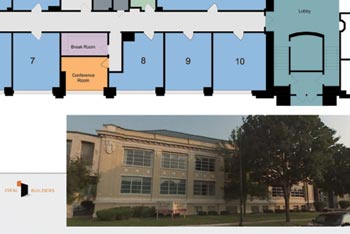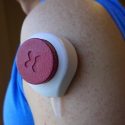New ‘urban research park’ offers jolt of electricity to Madison high-tech startups
After three decades of almost exponential commercial growth on Madison’s west side, the University Research Park (URP) will pursue an opportunity to sink roots downtown with an innovative “urban research park” targeting high-technology entrepreneurs.
URP Director Mark Bugher announced today that the park’s new urban campus will be located in 6,000 square feet of space leased in the former Marquip Building, 1245 East Washington Ave. (see map), and that renovations will begin later this summer to prepare the first ten incubator suites and two conference rooms. Both the building and the neighborhood may prove to be fertile ground for nurturing more entrepreneurial pursuits in information technology, engineering, medical devices and computer sciences start-up companies.
The facility should be ready to host new tenants in early 2009.
Marquip’s proximity to student and faculty talent at UW–Madison, as well as its placement in an “edgy, young and vibrant” part of the city, should make Madison a more visible player for high-tech companies, Bugher says. It also provides ready access to high-bandwidth fiber optic networks along the East Washington corridor. The suites will also be connected to the URPNet connection to campus Internet.
“This is part of a Wisconsin Idea-related effort to reach out in a strategically important way to help the economy of Madison and this particular part of the city,” says Bugher. “In addition to being a place for incubation, this also represents an economic development statement by the university: We can help Madison and surrounding communities grow their economies in positive ways.”

This floor layout concept drawing depicts the first set of suites that will be renovated in the new Urban Campus of University Research Park, located in the former Marquip Building at 1245 East Washington Ave. The 6,000-square-foot development is the first phase in a downtown economic development project to nurture more entrepreneurial pursuits in information technology, engineering, medical devices and computer sciences start-up companies.
The launching of the urban park is the culmination of two years of work and addresses a top priority of UW–Madison Chancellor John D. Wiley. It also helps solve one of the current park’s limitations — the lack of open commercial space. Even with a number of recent building projects, tenant demand has consistently outpaced available space in the landlocked 260-acre west-side park.
Wiley says the urban park, while starting small, has vast potential. Interest on campus in entrepreneurship has never been higher among students and faculty, as evidenced by the popularity of high-stakes competitions such as the Schoofs Prize for inventions and the Burrill Prize for business plans. UW–Madison has recently been named a Kauffman Foundation Entrepreneurship Campus, creating many more opportunities for students to envision and prepare for launching a business.
The UW–Madison Initiative for Studies in Technology Entrepreneurship (INSITE) has been tracking the remarkable volume of spinoff companies with direct ties to UW–Madison. Wiley says INSITE’s latest research survey has identified 385 companies that are traceable back to UW–Madison innovations.
“Almost all of those are traceable to individual faculty inventors, entrepreneurs or researchers,” Wiley says. “Yet we only have a couple thousand faculty members. What we’re seeing now is a huge increase, an explosion of interest, among our undergraduate and graduate students and post-docs in entrepreneurship and starting their own businesses.
“And that’s among 40,000 students — that’s 20 times more potential than just our faculty,” Wiley adds. “So I expect to see a great wave of new companies started by students.”
Adds Madison Mayor Dave Cieslewicz: “We’re delighted to have the UW Research Park downtown. It will no doubt build our local economy, strengthen the East Washington corridor and attract up-and-coming technology entrepreneurs to the area. This could be the spark for the East Rail Corridor redevelopment that we have been looking for.”
Cieslewicz notes the city’s $80 million investment in the rebuilding and beautification of East Washington Ave. and the city’s recent establishment of the Capitol Gateway tax incremental finance district as initiatives that will complement and bolster the UW’s project.
While the current park has been a magnet for medical and life sciences companies, Bugher says it has seemed less ideally suited for technology-based ventures, which tend to be smaller-scale, need less laboratory overhead and thrive more in eclectic, youth-oriented urban settings. Bugher says the urban park will work to be affordable to emerging companies that don’t have a lot of available capital or are still developing products.
Madison has been home to several technology business success stories in recent months. Information technology giants Microsoft and Google recently tapped faculty talent from the UW–Madison computer science department to establish research and development ventures downtown.
There are many interesting student startups percolating as well. Educated Investor — Precision Information Systems was started by UW–Madison alumnus Joe Saari after competing in the Burrill Competition for the best technology-based business plans. The company provides online learning tools for personal finance and is now up to 10 employees.
Another Company, Hardin Design and Development, was started out of UW–Madison junior Jon Hardin’s parent’s basement in spring 2007 and today has more than 20 employees on the Capitol Square. The company has created technology solutions for many high-profile clients, including MSN Money, CNN and Disney.
Computer Sciences Department Chair Mary Vernon agrees that the new research park is very well located for fostering further growth of the information technology industry in the Madison area. “The department is actively engaged in increasing its ties with local IT companies, and the new park will also facilitate those efforts,” she says.
Bugher says the end product at Marquip will be impressive once the remodeling is complete. “We’ll have state of the art infrastructure at the building and we’ll invest whatever it takes to make this a high-class, high-quality representative of our fine university.”
Subscribe to Wisconsin Ideas
Want more stories of the Wisconsin Idea in action? Sign-up for our monthly e-newsletter highlighting how Badgers are taking their education and research beyond the boundaries of the classroom to improve lives.



